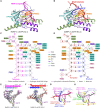Structural insights into the dual activities of the two-barrel RNA polymerase QDE-1
- PMID: 36039765
- PMCID: PMC9508822
- DOI: 10.1093/nar/gkac727
Structural insights into the dual activities of the two-barrel RNA polymerase QDE-1
Abstract
Neurospora crassa protein QDE-1, a member of the two-barrel polymerase superfamily, possesses both DNA- and RNA-dependent RNA polymerase (DdRP and RdRP) activities. The dual activities are essential for the production of double-stranded RNAs (dsRNAs), the precursors of small interfering RNAs (siRNAs) in N. crassa. Here, we report five complex structures of N-terminal truncated QDE-1 (QDE-1ΔN), representing four different reaction states: DNA/RNA-templated elongation, the de novo initiation of RNA synthesis, the first step of nucleotide condensation during de novo initiation and initial NTP loading. The template strand is aligned by a bridge-helix and double-psi beta-barrels 2 (DPBB2), the RNA product is held by DPBB1 and the slab domain. The DNA template unpairs with the RNA product at position -7, but the RNA template remains paired. The NTP analog coordinates with cations and is precisely positioned at the addition site by a rigid trigger loop and a proline-containing loop in the active center. The unique C-terminal tail from the QDE-1 dimer partner inserts into the substrate-binding cleft and plays regulatory roles in RNA synthesis. Collectively, this work elucidates the conserved mechanisms for DNA/RNA-dependent dual activities by QDE-1 and other two-barrel polymerase superfamily members.
© The Author(s) 2022. Published by Oxford University Press on behalf of Nucleic Acids Research.
Figures








Similar articles
-
In vitro activities of the multifunctional RNA silencing polymerase QDE-1 of Neurospora crassa.J Biol Chem. 2010 Sep 17;285(38):29367-74. doi: 10.1074/jbc.M110.139121. Epub 2010 Jul 20. J Biol Chem. 2010. PMID: 20647305 Free PMC article.
-
The DNA/RNA-dependent RNA polymerase QDE-1 generates aberrant RNA and dsRNA for RNAi in a process requiring replication protein A and a DNA helicase.PLoS Biol. 2010 Oct 5;8(10):e1000496. doi: 10.1371/journal.pbio.1000496. PLoS Biol. 2010. PMID: 20957187 Free PMC article.
-
qiRNA is a new type of small interfering RNA induced by DNA damage.Nature. 2009 May 14;459(7244):274-7. doi: 10.1038/nature08041. Nature. 2009. PMID: 19444217 Free PMC article.
-
The Extended "Two-Barrel" Polymerases Superfamily: Structure, Function and Evolution.J Mol Biol. 2019 Sep 20;431(20):4167-4183. doi: 10.1016/j.jmb.2019.05.017. Epub 2019 May 17. J Mol Biol. 2019. PMID: 31103775 Review.
-
In vitro production of synthetic viral RNAs and their delivery into mammalian cells and the application of viral RNAs in the study of innate interferon responses.Methods. 2020 Nov 1;183:21-29. doi: 10.1016/j.ymeth.2019.10.013. Epub 2019 Nov 1. Methods. 2020. PMID: 31682923 Review.
Cited by
-
DNA-dependent RNA polymerases in plants.Plant Cell. 2023 Sep 27;35(10):3641-3661. doi: 10.1093/plcell/koad195. Plant Cell. 2023. PMID: 37453082 Free PMC article.
-
RNA-Based Control of Fungal Pathogens in Plants.Int J Mol Sci. 2023 Aug 3;24(15):12391. doi: 10.3390/ijms241512391. Int J Mol Sci. 2023. PMID: 37569766 Free PMC article. Review.
-
Tail-tape-fused virion and non-virion RNA polymerases of a thermophilic virus with an extremely long tail.Nat Commun. 2024 Jan 5;15(1):317. doi: 10.1038/s41467-023-44630-z. Nat Commun. 2024. PMID: 38182597 Free PMC article.
References
-
- Cogoni C., Macino G.. Gene silencing in Neurospora crassa requires a protein homologous to RNA-dependent RNA polymerase. Nature. 1999; 399:166–169. - PubMed
-
- Dalmay T., Hamilton A., Rudd S., Angell S., Baulcombe D.C.. An RNA-dependent RNA polymerase gene in Arabidopsis is required for posttranscriptional gene silencing mediated by a transgene but not by a virus. Cell. 2000; 101:543–553. - PubMed
Publication types
MeSH terms
Substances
LinkOut - more resources
Full Text Sources
Research Materials

